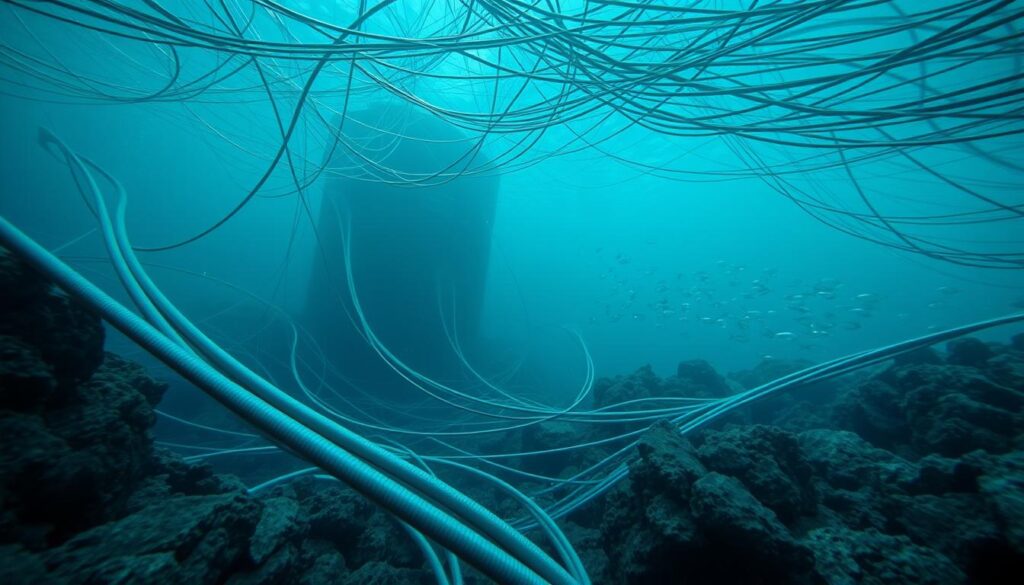The internet has changed how we live, work, and talk to each other. It’s full of internet facts and tech trivia. Knowing its history and growth is both interesting and key.
The web has grown a lot since it started. It’s now a global thing that affects almost every part of our lives. Looking into internet facts and tech trivia helps us see how it changed.
As we explore web history, we find a lot of new ideas and important moments. These have made the internet what it is today.
Key Takeaways
- Understanding the internet’s history is important to see its current impact.
- The web’s growth has been marked by big tech steps forward.
- Looking into internet facts and tech trivia shows the web’s depth and simplicity.
- The internet’s effect on society is wide, touching many parts of life.
- Learning about web history gives us insights into its future.
The Birth of the Internet: How ARPANET Changed Communication Forever
ARPANET was the start of the internet, changing how we talk to each other. It began in the late 1960s. It was the first network that sent data in packets, funded by the US Department of Defense’s Advanced Research Projects Agency (ARPA).
Understanding the Cold War Origins of Our Digital World
ARPANET was born in the Cold War era. Its main goal was to make a strong communication network that could keep working after a nuclear attack. It used packet switching, a method that sends data in small packets.
The Pentagon’s Role in Creating the Internet
The Pentagon was key in ARPANET’s creation. As the US Department of Defense’s headquarters, it funded and guided the project. The ARPA, a part of the Department of Defense, led ARPANET’s development and use.
Robert Taylor, a major figure in ARPANET, said,
“The ARPANET was not created to survive a nuclear war, but to make it easier for the Department of Defense and the research community to communicate.”
Decoding the First Message Ever Sent Online
The first message sent over ARPANET was “LOGIN.” But the system crashed after the first two letters. Later, the message was sent successfully, marking a big moment in internet history.
Why “LOGIN” Crashed the System and What It Taught Us
The crash was because of a bug. But it taught the developers the value of testing and fixing bugs. The successful “LOGIN” message later showed ARPANET’s power and led to today’s internet.
| Year | Event | Significance |
|---|---|---|
| 1969 | First message sent over ARPANET | Marked the beginning of the internet as we know it |
| 1983 | ARPANET adopted TCP/IP | Enabled different networks to communicate with each other |
Learning about ARPANET and its Cold War beginnings helps us understand the internet’s growth. From its start to today’s global network, ARPANET’s story is one of innovation and hard work.
How Tim Berners-Lee Transformed Research Sharing into the World Wide Web

Tim Berners-Lee changed how we share research forever. In the late 1980s, sharing information among researchers was hard. Berners-Lee, a British computer scientist, worked at CERN. He saw the need for a better way to share data.
He created the World Wide Web to solve this problem. This system made sharing information easy with web browsers and hyperlinks. It was a big change in how we communicate and find information.
The CERN Laboratory’s Unexpected Gift to Humanity
CERN played a key role in the World Wide Web’s creation. It was a lab focused on particle physics. But, it became the web’s birthplace because of the need for better information sharing.
From Proposal to Revolution: The Timeline
The World Wide Web’s development was fast. Here’s a quick timeline:
- 1989: Tim Berners-Lee proposes the World Wide Web project.
- 1990: The first web browser and server are developed.
- 1991: The World Wide Web is introduced to the public.
Navigating the Evolution from the First Browser to Modern Web
The first web browser was simple. It was text-based. Over time, it became the graphical browsers we know today, like Chrome and Firefox.
Key Innovations That Made the Web Accessible
| Innovation | Description | Year |
|---|---|---|
| First Web Browser | Basic text-based interface | 1990 |
| Graphical Browsers | Introduced visual elements and user-friendly interfaces | 1993 |
| Modern Web Standards | Improved accessibility and compatibility across devices | 2000s |
Why the Internet Weighs Approximately the Same as a Strawberry
Scientists have made interesting calculations about the internet’s weight. They compare it to a strawberry, which might seem strange. But it leads to a deep dive into the physical side of digital data.
The Science Behind Measuring Electron Weight in Data Transfer
The internet’s weight is the sum of the electrons in data. Data transfer happens through electrons in devices and cables. To figure out this weight, we look at the number of electrons and their mass.
Breaking Down the Calculation Process
Data moves through electronic devices, each with electrons. The mass of these electrons adds up to the data’s “weight.” Even though an electron’s mass is tiny (about 9.11 x 10^-31 kilograms), the number of electrons is huge.
How This Tiny Weight Supports Massive Global Communication
Despite the tiny weight of electrons, they support a huge network for global communication. This shows how technology and engineering have advanced.
The Efficiency of Digital Information Transfer
Digital information transfer is very efficient. It lets us send lots of data worldwide without a big physical load. This efficiency is key for modern communication, from texts to big data exchanges.
In summary, comparing the internet’s weight to a strawberry is more than a fun fact. It shows the complex science and technology behind our digital lives. It gives us a peek into the world of tech trivia and internet facts.
10 Mind-Blowing Facts You Didn’t Know About the Internet’s Physical Infrastructure

Exploring the internet’s infrastructure reveals amazing facts about underwater cables. The internet’s backbone is real, made of physical cables around the world. These cables are both on land and underwater.
Mapping the Underwater Cable Network That Powers Your Searches
The underwater cable network is a true marvel. It spans over 400,000 miles across the ocean floor. These cables carry more than 95% of international data traffic.
The Most Critical Cable Routes and Their Vulnerabilities
Critical cable routes face dangers like busy shipping lanes and natural disasters. For example, the Strait of Malacca is a key spot due to its heavy traffic and geopolitical importance.
- The Strait of Malacca is a key route for international trade and data transfer.
- Cables in these areas are more susceptible to damage from anchors and fishing gear.
- Geopolitical tensions can also pose a risk to these critical infrastructure points.
How Engineers Protect These Vital Cables from Natural Threats
Engineers work hard to protect underwater cables from threats like earthquakes and landslides. Shark bites have also damaged cables, leading to new solutions.
Innovative Solutions to Shark Attacks and Environmental Damage
To fight shark attacks, some cables are now wrapped in shark-repellent material or buried under the seabed. Also, environmental concerns are being considered in cable laying and maintenance to reduce ecological harm.
- Using armored cables that can withstand harsh underwater conditions.
- Implementing monitoring systems to detect cable faults early.
- Conducting environmental impact assessments before laying new cables.
How a Coffee Pot Inspired the First Webcam and Changed Visual Communication
A coffee pot was the unlikely start of the first webcam. This tech trivia shows how a common issue led to a big internet fact: the creation of webcam technology.
The Cambridge Computer Lab’s Accidental Innovation
In the early 1990s, researchers at Cambridge University’s Computer Laboratory had a problem. They often found the lab’s coffee pot empty. To solve this, they set up a camera to watch the coffee pot from afar. This simple fix turned into the world’s first webcam.
From Practical Solution to Technological Breakthrough
The first webcam showed images of the coffee pot online. This let researchers check the coffee pot’s status without leaving their desks. It was an early example of how tech can make our lives easier.
Tracing the Evolution from Coffee Monitoring to Video Streaming Empire
The webcam tech from Cambridge started the video streaming world. As internet speeds and camera tech improved, webcams became better. They went from simple tools to high-quality video conferencing and streaming devices.
Key Milestones in Webcam Technology Development
Important steps included better cameras and webcams in video calls and entertainment. These changes show the big impact of the coffee pot idea.
Now, webcams are key to our digital lives. They help with remote work, online learning, and staying in touch. The story of the first webcam is a cool internet fact. It shows how a small problem can lead to big tech changes.
Understanding the Digital Divide: Why Half the World Remains Offline

The digital age has brought us closer together, but half the world is still offline. This gap, known as the digital divide, is caused by many factors. These include where we live, how much money we have, and our social status.
Analyzing the Geographic and Economic Barriers to Access
Living in rural or remote areas makes it hard to get online. These places often don’t have the internet infrastructure we need. The cost of devices and internet plans is also a big barrier for many.
The Countries with Lowest Internet Penetration
Some countries have very low internet use rates. These include:
- South Sudan
- Central African Republic
- Chad
- Niger
- Eritrea
These countries face big challenges. They lack infrastructure, deal with political instability, and struggle financially. All these issues make it harder for them to get online.
How Organizations Are Working to Bridge the Global Connectivity Gap
Many groups are working hard to close the digital divide. They use low-cost internet tech and offer affordable internet to those who need it most.
Successful Models for Expanding Internet Access
There are successful ways to get more people online. These include:
- Community Networks: These are local networks that provide internet access.
- Satellite Internet: This uses satellites to bring internet to remote areas.
- Mobile Internet Initiatives: These use mobile networks to offer cheap data plans.
These examples show that we can reach even the most remote areas with the internet.
How the Internet’s Energy Consumption Rivals Entire Nations

The internet’s energy use is huge and often ignored. It’s as much as whole countries use. As we use more digital stuff, knowing the cost of our online actions is key.
The internet’s energy use comes from data centers, networks, and devices online. This big network uses a lot of electricity. It worries us about the planet and if it’s sustainable.
Calculating the True Power Requirements of Our Digital Activities
To understand the internet’s energy use, we must look at its parts. Data centers, which hold lots of digital info, use a lot of energy.
The Energy Cost of Streaming, Searching, and Cloud Storage
Things like streaming videos and searching online use a lot of energy. For example, one data center can use as much power as a small town. This shows how much energy our digital lives need.
Exploring Green Solutions for Sustainable Internet Growth
As worries about the internet’s energy use grow, so does the search for green solutions. Using renewable energy to power data centers and internet stuff is a good idea.
Renewable Energy Initiatives in Data Centers
Many tech companies are using solar and wind power to cut their carbon footprint. Switching to clean energy makes the internet more eco-friendly. It helps lessen its harm to the environment.
Navigating the Misunderstood Dimensions of the Dark Web
As we delve into the internet’s depths, we find the dark web. It’s a mysterious place often misunderstood. The dark web is not found by regular search engines and needs special software to enter.
Distinguishing Between Surface Web, Deep Web, and Dark Web
The internet has three main layers: the surface web, the deep web, and the dark web. The surface web is easy to find and indexed by search engines. The deep web is not indexed but can be reached with standard browsers, needing specific URLs or login details.
The dark web is a part of the deep web, hidden on purpose. It’s not reachable with regular browsers. You need special software, like Tor, to get in.
Size Comparisons and Access Methods
It’s hard to say how big the dark web is because it’s hidden. But it’s thought to be smaller than the deep web. To get to the dark web, you must use browsers like Tor, which hide your online activity.
Debunking Popular Myths About the Internet’s Most Mysterious Layer
Many myths surround the dark web, making it seem like a place without rules. While it’s true some illegal things happen here, it also has legal content. For example, it has platforms for whistleblowers and tools for keeping your online life private.
Legitimate Uses Alongside Illicit Activities
The dark web has many good uses. It’s a safe space for whistleblowers and activists to talk without being found. It also has forums and resources for those who value privacy and security.
To truly understand the dark web, we must see both its good and bad sides. This way, we can clear up the mystery surrounding it.
The Evolution of Domain Names: From Symbolics.com to Digital Real Estate Empire
The story of domain names is a tale of innovation and entrepreneurship. As the internet grew, finding websites became crucial. Domain names were the answer, making it easier to remember websites instead of complex IP addresses.
Tracking the History of the First Registered Domains
In the early days, registering domains was a mix of curiosity and vision. Companies and individuals wanted a unique online identity.
The Companies That Secured Internet History
Pioneers like Symbolics, BBN, and IBM registered domains early. These actions not only secured their online space but also shaped the internet we use today.
- Symbolics.com – Registered on March 15, 1985
- BBN.com – Registered on April 24, 1985
- IBM.com – Registered on March 19, 1986
How Domain Name Valuation Transformed into a Multi-Billion Dollar Market
As the internet grew, domain names became more valuable. Today, they are seen as valuable digital assets, with some selling for millions.
Record-Breaking Domain Sales and Their Stories
Domain name sales have hit record highs. For example, Voice.com was sold for $30 million. This shows the huge potential for returns in the domain name market.
| Domain Name | Sale Price |
|---|---|
| Voice.com | $30 million |
| FD.com | $1.2 million |
Conclusion: Leveraging Internet History to Understand Our Digital Future
Looking back, the internet has grown from a simple idea to a vast network. Key moments like the start of ARPANET and the World Wide Web by Tim Berners-Lee have changed how we talk and find information. This shows how vital knowing its history is for its future.
Delving into tech trivia and web history uncovers the complex systems behind our online lives. From underwater cables to data centers, it’s all part of our digital world. Yet, we face issues like the digital divide and energy use as it grows.
By learning from the past, we can get ready for what’s next. As tech keeps evolving, knowing the internet’s history is key. It helps us build a more connected and green digital world.

